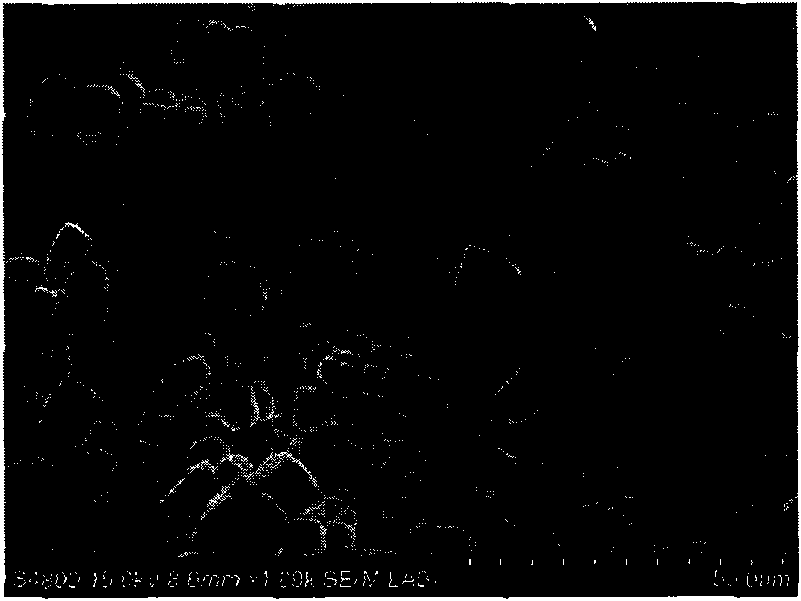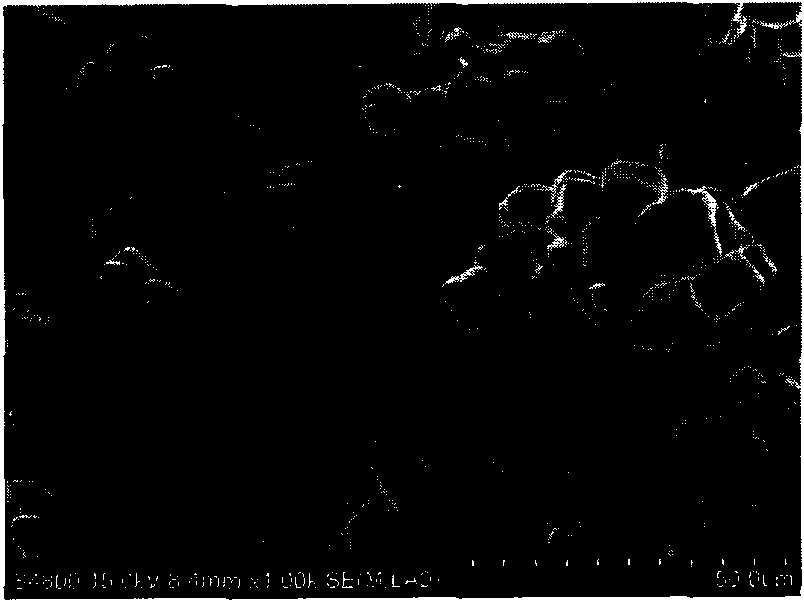Preparation method for micron order superfine sodium chloride
A sodium chloride and micron-level technology, which is applied in the field of preparing micron-level ultrafine sodium chloride, can solve the problems of easy clogging of nozzles, difficulty in preparing micron-level ultrafine sodium chloride, environmental hazards of ultrasonic technology, etc.
- Summary
- Abstract
- Description
- Claims
- Application Information
AI Technical Summary
Problems solved by technology
Method used
Image
Examples
Embodiment 1
[0017] At room temperature, add 50 ml of ethanol to 50 ml of sodium chloride saturated aqueous solution without adding modifiers, stir for half an hour, quickly filter to collect the crystals, and dry in a vacuum drying oven at 80°C.
[0018] Scan the surface morphology with a scanning electron microscope (SEM) and calculate the particle size.
[0019] When using different proportions of ethanol as an anti-solvent to prepare ultrafine sodium chloride, the particle size of sodium chloride is distributed around a few microns. When the amount of ethanol is 50 ml, the particle size of sodium chloride is 7.07 μm; the primary crystal yield is 41.4%.
[0020] The scan results are attached figure 1 .
Embodiment 2
[0022] At room temperature, add 100ml of ethanol to 50ml of sodium chloride saturated aqueous solution without adding modifiers, stir for half an hour, quickly filter to collect the crystals, and dry in a vacuum drying oven at 80°C.
[0023] Scan the surface morphology with a scanning electron microscope (SEM) and calculate the particle size.
[0024] When using different proportions of ethanol as an anti-solvent to prepare ultrafine sodium chloride, the particle size of sodium chloride is distributed around a few microns. When the amount of ethanol is 100 ml, the particle size of sodium chloride is 9.07 μm; the primary crystal yield is 60.2%.
[0025] The scan results are attached figure 2 .
Embodiment 3
[0027] At room temperature, add 200ml of ethanol to 50ml of sodium chloride saturated aqueous solution without adding modifiers, stir for half an hour, quickly filter to collect the crystals, and dry in a vacuum drying oven at 80°C.
[0028] Scan the surface morphology with a scanning electron microscope (SEM) and calculate the particle size.
[0029] When using different proportions of ethanol as an anti-solvent to prepare ultrafine sodium chloride, the particle size of sodium chloride is distributed around a few microns. When the amount of ethanol is 200 ml, the particle size of sodium chloride is 3.68 μm; the primary crystal yield is 76.5%.
[0030] The scan results are attached image 3 .
PUM
| Property | Measurement | Unit |
|---|---|---|
| Particle size | aaaaa | aaaaa |
| Particle size | aaaaa | aaaaa |
| Particle size | aaaaa | aaaaa |
Abstract
Description
Claims
Application Information
 Login to View More
Login to View More - R&D
- Intellectual Property
- Life Sciences
- Materials
- Tech Scout
- Unparalleled Data Quality
- Higher Quality Content
- 60% Fewer Hallucinations
Browse by: Latest US Patents, China's latest patents, Technical Efficacy Thesaurus, Application Domain, Technology Topic, Popular Technical Reports.
© 2025 PatSnap. All rights reserved.Legal|Privacy policy|Modern Slavery Act Transparency Statement|Sitemap|About US| Contact US: help@patsnap.com



